International Finance: Barclays and Royal Bank of Scotland Acquisition
VerifiedAdded on 2020/07/22
|15
|3210
|36
Report
AI Summary
This report analyzes the potential acquisition of the Royal Bank of Scotland (RBS) by Barclays, focusing on the financial viability of the deal. The introduction highlights the importance of financial tools in assessing acquisition plans. Task 1 uses ratio analysis to evaluate RBS's financial performance in 2015 and 2016, including profitability, solvency, and efficiency ratios, concluding that Barclays should avoid the acquisition due to RBS's poor financial health. Task 2 explores the advantages and disadvantages of net asset, price-earnings, and dividend valuation methods, providing computations of intrinsic value based on these methods. The report explains the reasons for valuation differences and identifies various risk exposures faced by RBS, emphasizing the negative impact on market share and investor confidence. Recommendations are provided in Task 3, and the conclusion summarizes the findings, reinforcing the recommendation against the acquisition. The report emphasizes the importance of competent policy frameworks for financial improvement.

International Finance
Paraphrase This Document
Need a fresh take? Get an instant paraphrase of this document with our AI Paraphraser
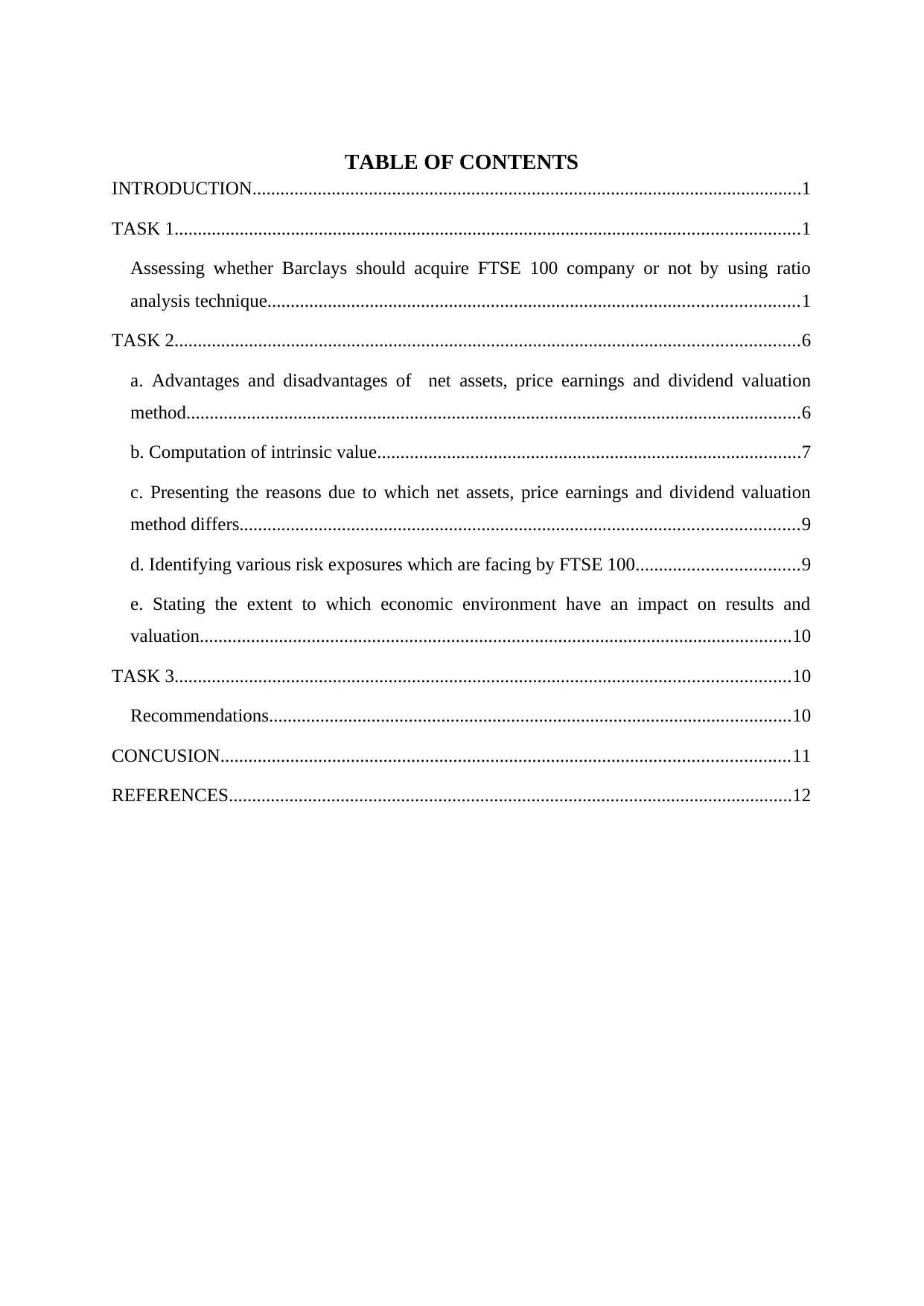
TABLE OF CONTENTS
INTRODUCTION......................................................................................................................1
TASK 1......................................................................................................................................1
Assessing whether Barclays should acquire FTSE 100 company or not by using ratio
analysis technique..................................................................................................................1
TASK 2......................................................................................................................................6
a. Advantages and disadvantages of net assets, price earnings and dividend valuation
method....................................................................................................................................6
b. Computation of intrinsic value...........................................................................................7
c. Presenting the reasons due to which net assets, price earnings and dividend valuation
method differs........................................................................................................................9
d. Identifying various risk exposures which are facing by FTSE 100...................................9
e. Stating the extent to which economic environment have an impact on results and
valuation...............................................................................................................................10
TASK 3....................................................................................................................................10
Recommendations................................................................................................................10
CONCUSION..........................................................................................................................11
REFERENCES.........................................................................................................................12
INTRODUCTION......................................................................................................................1
TASK 1......................................................................................................................................1
Assessing whether Barclays should acquire FTSE 100 company or not by using ratio
analysis technique..................................................................................................................1
TASK 2......................................................................................................................................6
a. Advantages and disadvantages of net assets, price earnings and dividend valuation
method....................................................................................................................................6
b. Computation of intrinsic value...........................................................................................7
c. Presenting the reasons due to which net assets, price earnings and dividend valuation
method differs........................................................................................................................9
d. Identifying various risk exposures which are facing by FTSE 100...................................9
e. Stating the extent to which economic environment have an impact on results and
valuation...............................................................................................................................10
TASK 3....................................................................................................................................10
Recommendations................................................................................................................10
CONCUSION..........................................................................................................................11
REFERENCES.........................................................................................................................12
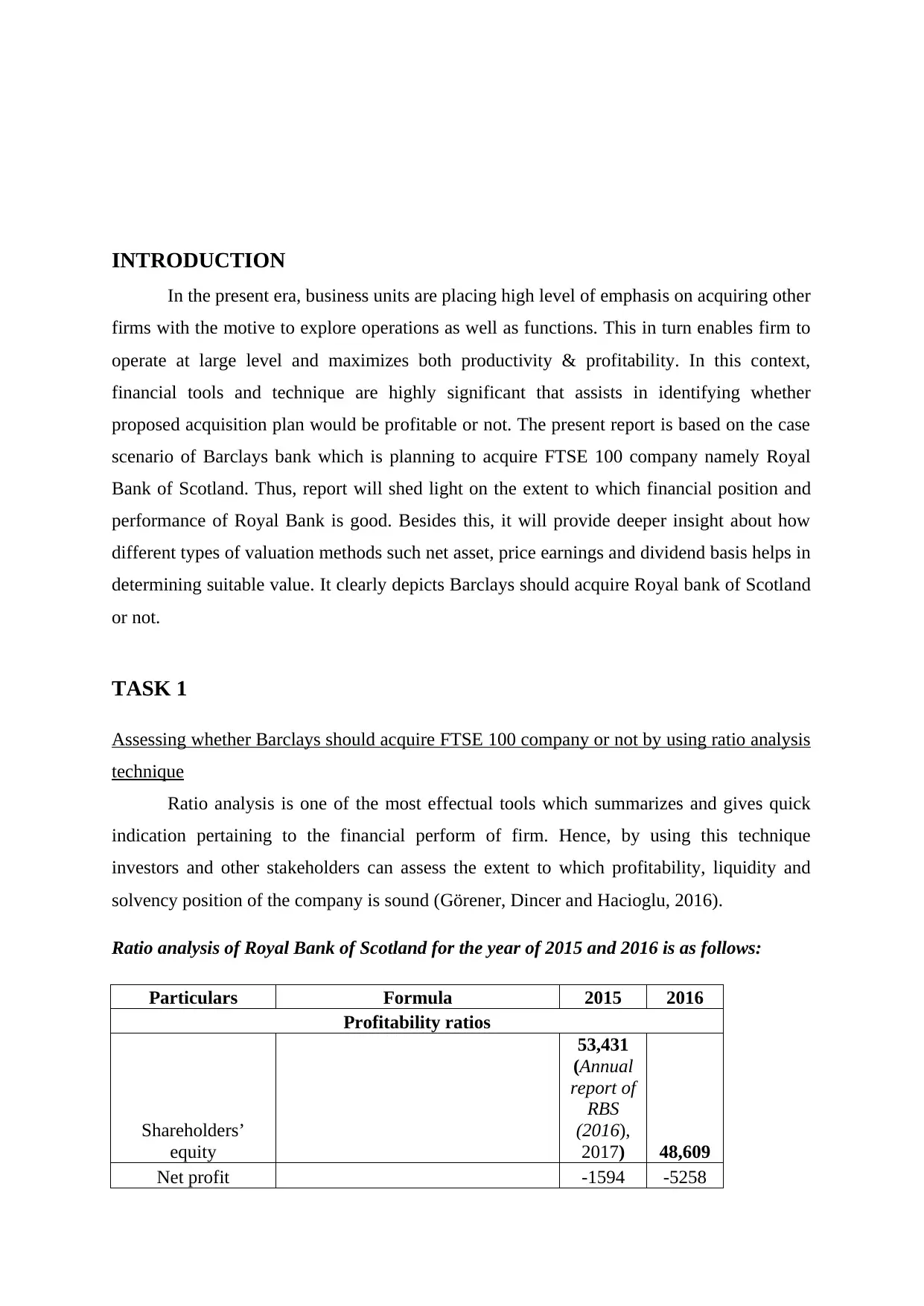
INTRODUCTION
In the present era, business units are placing high level of emphasis on acquiring other
firms with the motive to explore operations as well as functions. This in turn enables firm to
operate at large level and maximizes both productivity & profitability. In this context,
financial tools and technique are highly significant that assists in identifying whether
proposed acquisition plan would be profitable or not. The present report is based on the case
scenario of Barclays bank which is planning to acquire FTSE 100 company namely Royal
Bank of Scotland. Thus, report will shed light on the extent to which financial position and
performance of Royal Bank is good. Besides this, it will provide deeper insight about how
different types of valuation methods such net asset, price earnings and dividend basis helps in
determining suitable value. It clearly depicts Barclays should acquire Royal bank of Scotland
or not.
TASK 1
Assessing whether Barclays should acquire FTSE 100 company or not by using ratio analysis
technique
Ratio analysis is one of the most effectual tools which summarizes and gives quick
indication pertaining to the financial perform of firm. Hence, by using this technique
investors and other stakeholders can assess the extent to which profitability, liquidity and
solvency position of the company is sound (Görener, Dincer and Hacioglu, 2016).
Ratio analysis of Royal Bank of Scotland for the year of 2015 and 2016 is as follows:
Particulars Formula 2015 2016
Profitability ratios
Shareholders’
equity
53,431
(Annual
report of
RBS
(2016),
2017) 48,609
Net profit -1594 -5258
In the present era, business units are placing high level of emphasis on acquiring other
firms with the motive to explore operations as well as functions. This in turn enables firm to
operate at large level and maximizes both productivity & profitability. In this context,
financial tools and technique are highly significant that assists in identifying whether
proposed acquisition plan would be profitable or not. The present report is based on the case
scenario of Barclays bank which is planning to acquire FTSE 100 company namely Royal
Bank of Scotland. Thus, report will shed light on the extent to which financial position and
performance of Royal Bank is good. Besides this, it will provide deeper insight about how
different types of valuation methods such net asset, price earnings and dividend basis helps in
determining suitable value. It clearly depicts Barclays should acquire Royal bank of Scotland
or not.
TASK 1
Assessing whether Barclays should acquire FTSE 100 company or not by using ratio analysis
technique
Ratio analysis is one of the most effectual tools which summarizes and gives quick
indication pertaining to the financial perform of firm. Hence, by using this technique
investors and other stakeholders can assess the extent to which profitability, liquidity and
solvency position of the company is sound (Görener, Dincer and Hacioglu, 2016).
Ratio analysis of Royal Bank of Scotland for the year of 2015 and 2016 is as follows:
Particulars Formula 2015 2016
Profitability ratios
Shareholders’
equity
53,431
(Annual
report of
RBS
(2016),
2017) 48,609
Net profit -1594 -5258
⊘ This is a preview!⊘
Do you want full access?
Subscribe today to unlock all pages.

Trusted by 1+ million students worldwide
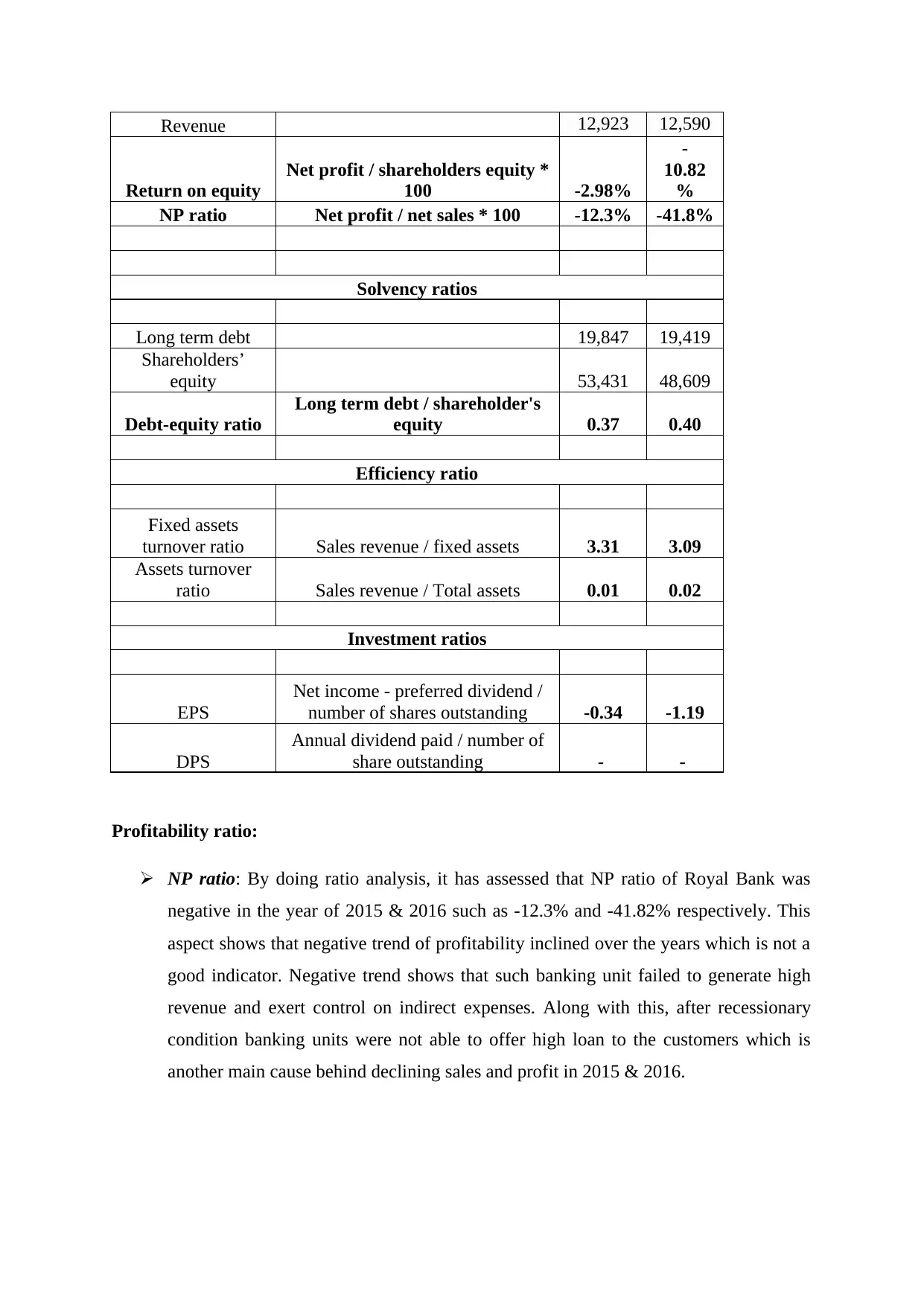
Revenue 12,923 12,590
Return on equity
Net profit / shareholders equity *
100 -2.98%
-
10.82
%
NP ratio Net profit / net sales * 100 -12.3% -41.8%
Solvency ratios
Long term debt 19,847 19,419
Shareholders’
equity 53,431 48,609
Debt-equity ratio
Long term debt / shareholder's
equity 0.37 0.40
Efficiency ratio
Fixed assets
turnover ratio Sales revenue / fixed assets 3.31 3.09
Assets turnover
ratio Sales revenue / Total assets 0.01 0.02
Investment ratios
EPS
Net income - preferred dividend /
number of shares outstanding -0.34 -1.19
DPS
Annual dividend paid / number of
share outstanding - -
Profitability ratio:
NP ratio: By doing ratio analysis, it has assessed that NP ratio of Royal Bank was
negative in the year of 2015 & 2016 such as -12.3% and -41.82% respectively. This
aspect shows that negative trend of profitability inclined over the years which is not a
good indicator. Negative trend shows that such banking unit failed to generate high
revenue and exert control on indirect expenses. Along with this, after recessionary
condition banking units were not able to offer high loan to the customers which is
another main cause behind declining sales and profit in 2015 & 2016.
Return on equity
Net profit / shareholders equity *
100 -2.98%
-
10.82
%
NP ratio Net profit / net sales * 100 -12.3% -41.8%
Solvency ratios
Long term debt 19,847 19,419
Shareholders’
equity 53,431 48,609
Debt-equity ratio
Long term debt / shareholder's
equity 0.37 0.40
Efficiency ratio
Fixed assets
turnover ratio Sales revenue / fixed assets 3.31 3.09
Assets turnover
ratio Sales revenue / Total assets 0.01 0.02
Investment ratios
EPS
Net income - preferred dividend /
number of shares outstanding -0.34 -1.19
DPS
Annual dividend paid / number of
share outstanding - -
Profitability ratio:
NP ratio: By doing ratio analysis, it has assessed that NP ratio of Royal Bank was
negative in the year of 2015 & 2016 such as -12.3% and -41.82% respectively. This
aspect shows that negative trend of profitability inclined over the years which is not a
good indicator. Negative trend shows that such banking unit failed to generate high
revenue and exert control on indirect expenses. Along with this, after recessionary
condition banking units were not able to offer high loan to the customers which is
another main cause behind declining sales and profit in 2015 & 2016.
Paraphrase This Document
Need a fresh take? Get an instant paraphrase of this document with our AI Paraphraser
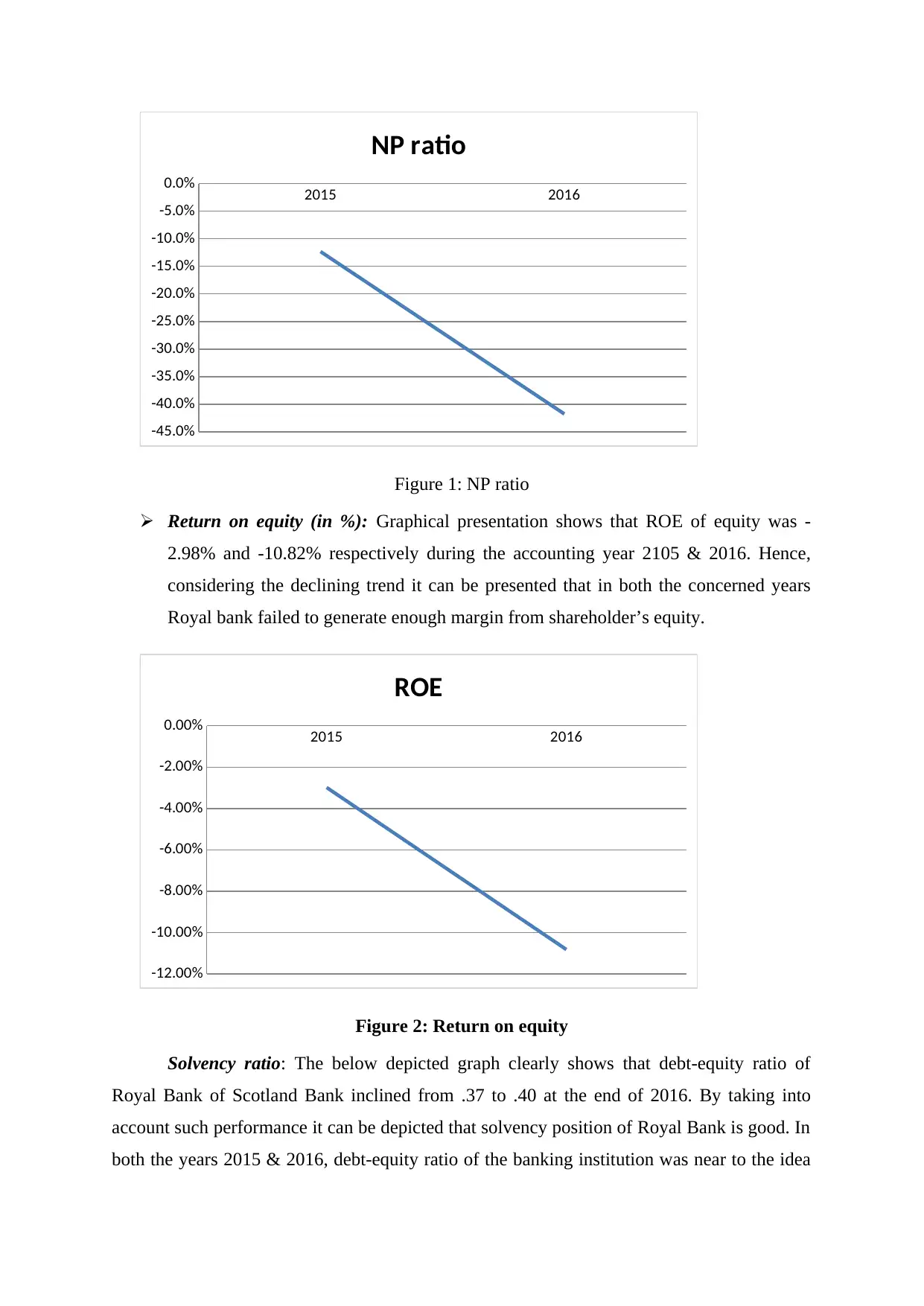
2015 2016
-45.0%
-40.0%
-35.0%
-30.0%
-25.0%
-20.0%
-15.0%
-10.0%
-5.0%
0.0%
NP ratio
Figure 1: NP ratio
Return on equity (in %): Graphical presentation shows that ROE of equity was -
2.98% and -10.82% respectively during the accounting year 2105 & 2016. Hence,
considering the declining trend it can be presented that in both the concerned years
Royal bank failed to generate enough margin from shareholder’s equity.
2015 2016
-12.00%
-10.00%
-8.00%
-6.00%
-4.00%
-2.00%
0.00%
ROE
Figure 2: Return on equity
Solvency ratio: The below depicted graph clearly shows that debt-equity ratio of
Royal Bank of Scotland Bank inclined from .37 to .40 at the end of 2016. By taking into
account such performance it can be depicted that solvency position of Royal Bank is good. In
both the years 2015 & 2016, debt-equity ratio of the banking institution was near to the idea
-45.0%
-40.0%
-35.0%
-30.0%
-25.0%
-20.0%
-15.0%
-10.0%
-5.0%
0.0%
NP ratio
Figure 1: NP ratio
Return on equity (in %): Graphical presentation shows that ROE of equity was -
2.98% and -10.82% respectively during the accounting year 2105 & 2016. Hence,
considering the declining trend it can be presented that in both the concerned years
Royal bank failed to generate enough margin from shareholder’s equity.
2015 2016
-12.00%
-10.00%
-8.00%
-6.00%
-4.00%
-2.00%
0.00%
ROE
Figure 2: Return on equity
Solvency ratio: The below depicted graph clearly shows that debt-equity ratio of
Royal Bank of Scotland Bank inclined from .37 to .40 at the end of 2016. By taking into
account such performance it can be depicted that solvency position of Royal Bank is good. In
both the years 2015 & 2016, debt-equity ratio of the banking institution was near to the idea
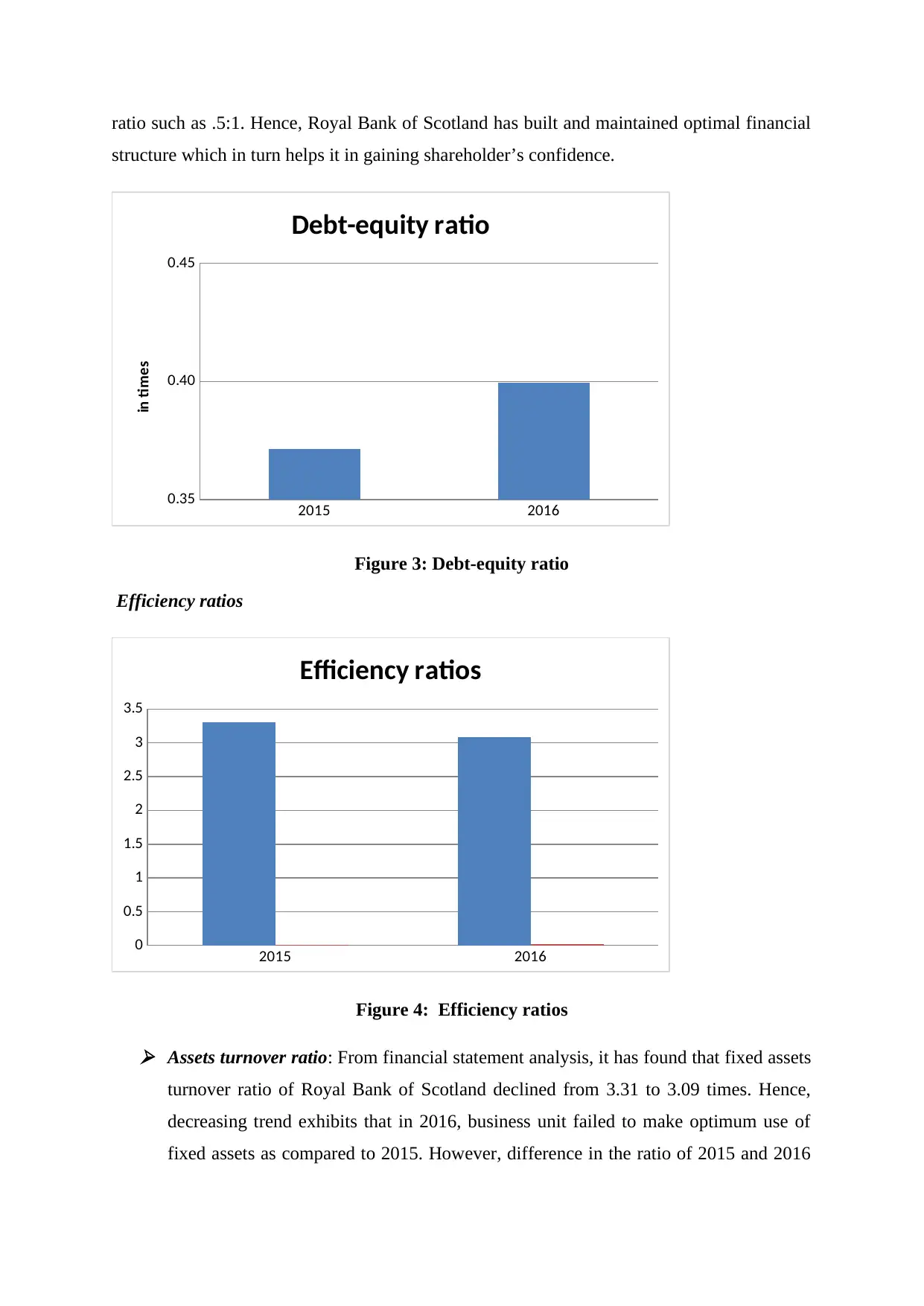
ratio such as .5:1. Hence, Royal Bank of Scotland has built and maintained optimal financial
structure which in turn helps it in gaining shareholder’s confidence.
2015 2016
0.35
0.40
0.45
Debt-equity ratio
in times
Figure 3: Debt-equity ratio
Efficiency ratios
2015 2016
0
0.5
1
1.5
2
2.5
3
3.5
Efficiency ratios
Figure 4: Efficiency ratios
Assets turnover ratio: From financial statement analysis, it has found that fixed assets
turnover ratio of Royal Bank of Scotland declined from 3.31 to 3.09 times. Hence,
decreasing trend exhibits that in 2016, business unit failed to make optimum use of
fixed assets as compared to 2015. However, difference in the ratio of 2015 and 2016
structure which in turn helps it in gaining shareholder’s confidence.
2015 2016
0.35
0.40
0.45
Debt-equity ratio
in times
Figure 3: Debt-equity ratio
Efficiency ratios
2015 2016
0
0.5
1
1.5
2
2.5
3
3.5
Efficiency ratios
Figure 4: Efficiency ratios
Assets turnover ratio: From financial statement analysis, it has found that fixed assets
turnover ratio of Royal Bank of Scotland declined from 3.31 to 3.09 times. Hence,
decreasing trend exhibits that in 2016, business unit failed to make optimum use of
fixed assets as compared to 2015. However, difference in the ratio of 2015 and 2016
⊘ This is a preview!⊘
Do you want full access?
Subscribe today to unlock all pages.

Trusted by 1+ million students worldwide
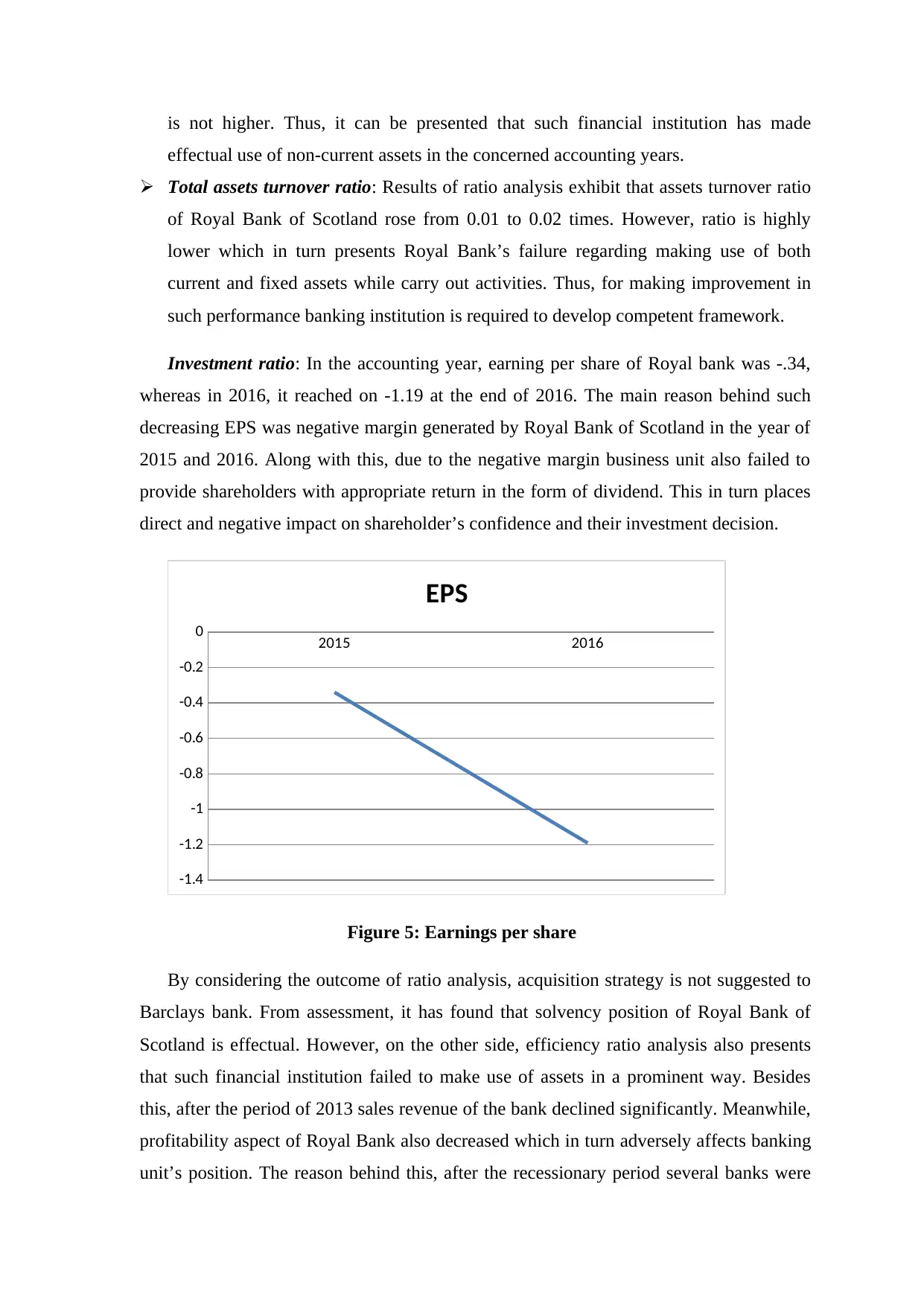
is not higher. Thus, it can be presented that such financial institution has made
effectual use of non-current assets in the concerned accounting years.
Total assets turnover ratio: Results of ratio analysis exhibit that assets turnover ratio
of Royal Bank of Scotland rose from 0.01 to 0.02 times. However, ratio is highly
lower which in turn presents Royal Bank’s failure regarding making use of both
current and fixed assets while carry out activities. Thus, for making improvement in
such performance banking institution is required to develop competent framework.
Investment ratio: In the accounting year, earning per share of Royal bank was -.34,
whereas in 2016, it reached on -1.19 at the end of 2016. The main reason behind such
decreasing EPS was negative margin generated by Royal Bank of Scotland in the year of
2015 and 2016. Along with this, due to the negative margin business unit also failed to
provide shareholders with appropriate return in the form of dividend. This in turn places
direct and negative impact on shareholder’s confidence and their investment decision.
2015 2016
-1.4
-1.2
-1
-0.8
-0.6
-0.4
-0.2
0
EPS
Figure 5: Earnings per share
By considering the outcome of ratio analysis, acquisition strategy is not suggested to
Barclays bank. From assessment, it has found that solvency position of Royal Bank of
Scotland is effectual. However, on the other side, efficiency ratio analysis also presents
that such financial institution failed to make use of assets in a prominent way. Besides
this, after the period of 2013 sales revenue of the bank declined significantly. Meanwhile,
profitability aspect of Royal Bank also decreased which in turn adversely affects banking
unit’s position. The reason behind this, after the recessionary period several banks were
effectual use of non-current assets in the concerned accounting years.
Total assets turnover ratio: Results of ratio analysis exhibit that assets turnover ratio
of Royal Bank of Scotland rose from 0.01 to 0.02 times. However, ratio is highly
lower which in turn presents Royal Bank’s failure regarding making use of both
current and fixed assets while carry out activities. Thus, for making improvement in
such performance banking institution is required to develop competent framework.
Investment ratio: In the accounting year, earning per share of Royal bank was -.34,
whereas in 2016, it reached on -1.19 at the end of 2016. The main reason behind such
decreasing EPS was negative margin generated by Royal Bank of Scotland in the year of
2015 and 2016. Along with this, due to the negative margin business unit also failed to
provide shareholders with appropriate return in the form of dividend. This in turn places
direct and negative impact on shareholder’s confidence and their investment decision.
2015 2016
-1.4
-1.2
-1
-0.8
-0.6
-0.4
-0.2
0
EPS
Figure 5: Earnings per share
By considering the outcome of ratio analysis, acquisition strategy is not suggested to
Barclays bank. From assessment, it has found that solvency position of Royal Bank of
Scotland is effectual. However, on the other side, efficiency ratio analysis also presents
that such financial institution failed to make use of assets in a prominent way. Besides
this, after the period of 2013 sales revenue of the bank declined significantly. Meanwhile,
profitability aspect of Royal Bank also decreased which in turn adversely affects banking
unit’s position. The reason behind this, after the recessionary period several banks were
Paraphrase This Document
Need a fresh take? Get an instant paraphrase of this document with our AI Paraphraser
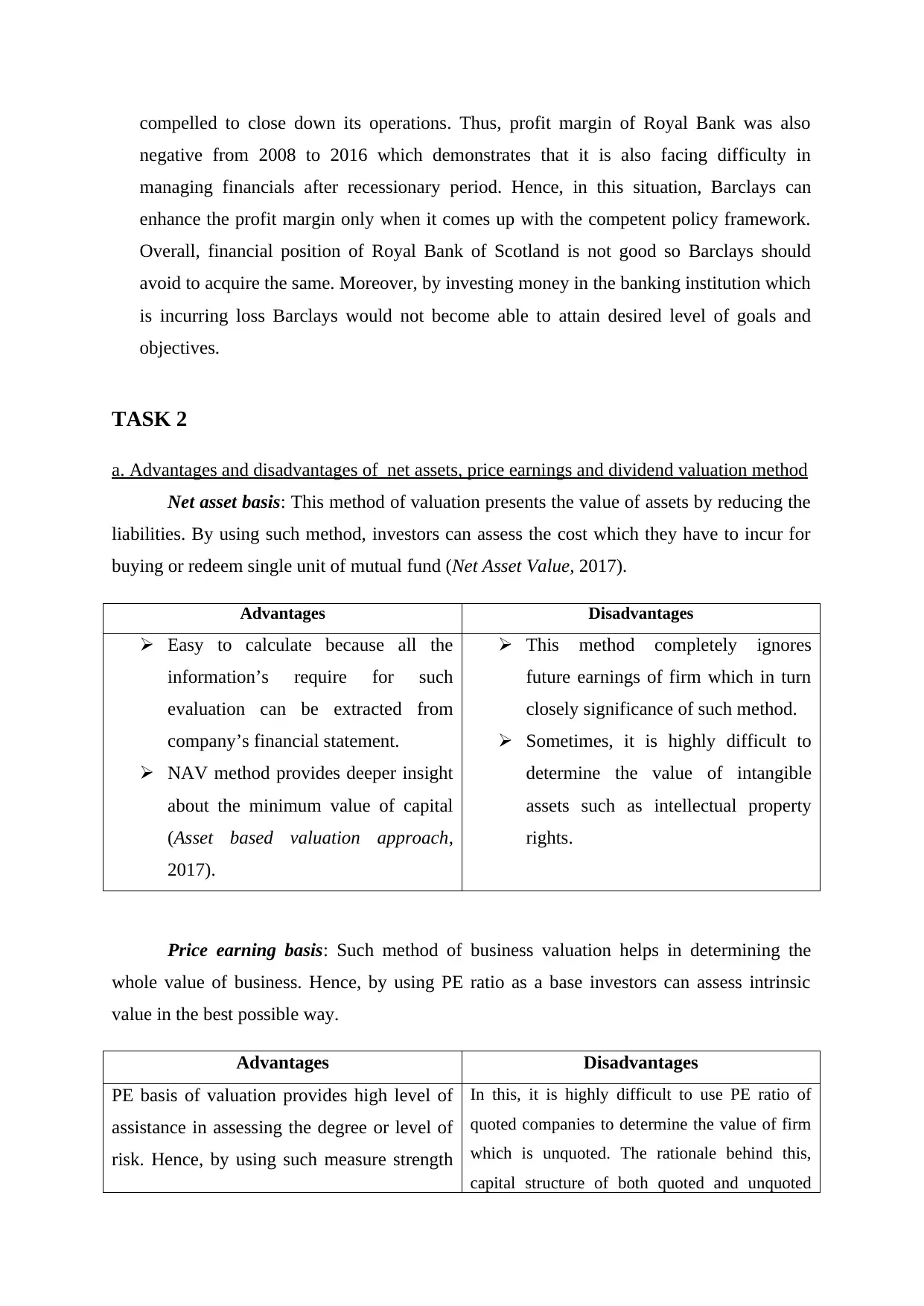
compelled to close down its operations. Thus, profit margin of Royal Bank was also
negative from 2008 to 2016 which demonstrates that it is also facing difficulty in
managing financials after recessionary period. Hence, in this situation, Barclays can
enhance the profit margin only when it comes up with the competent policy framework.
Overall, financial position of Royal Bank of Scotland is not good so Barclays should
avoid to acquire the same. Moreover, by investing money in the banking institution which
is incurring loss Barclays would not become able to attain desired level of goals and
objectives.
TASK 2
a. Advantages and disadvantages of net assets, price earnings and dividend valuation method
Net asset basis: This method of valuation presents the value of assets by reducing the
liabilities. By using such method, investors can assess the cost which they have to incur for
buying or redeem single unit of mutual fund (Net Asset Value, 2017).
Advantages Disadvantages
Easy to calculate because all the
information’s require for such
evaluation can be extracted from
company’s financial statement.
NAV method provides deeper insight
about the minimum value of capital
(Asset based valuation approach,
2017).
This method completely ignores
future earnings of firm which in turn
closely significance of such method.
Sometimes, it is highly difficult to
determine the value of intangible
assets such as intellectual property
rights.
Price earning basis: Such method of business valuation helps in determining the
whole value of business. Hence, by using PE ratio as a base investors can assess intrinsic
value in the best possible way.
Advantages Disadvantages
PE basis of valuation provides high level of
assistance in assessing the degree or level of
risk. Hence, by using such measure strength
In this, it is highly difficult to use PE ratio of
quoted companies to determine the value of firm
which is unquoted. The rationale behind this,
capital structure of both quoted and unquoted
negative from 2008 to 2016 which demonstrates that it is also facing difficulty in
managing financials after recessionary period. Hence, in this situation, Barclays can
enhance the profit margin only when it comes up with the competent policy framework.
Overall, financial position of Royal Bank of Scotland is not good so Barclays should
avoid to acquire the same. Moreover, by investing money in the banking institution which
is incurring loss Barclays would not become able to attain desired level of goals and
objectives.
TASK 2
a. Advantages and disadvantages of net assets, price earnings and dividend valuation method
Net asset basis: This method of valuation presents the value of assets by reducing the
liabilities. By using such method, investors can assess the cost which they have to incur for
buying or redeem single unit of mutual fund (Net Asset Value, 2017).
Advantages Disadvantages
Easy to calculate because all the
information’s require for such
evaluation can be extracted from
company’s financial statement.
NAV method provides deeper insight
about the minimum value of capital
(Asset based valuation approach,
2017).
This method completely ignores
future earnings of firm which in turn
closely significance of such method.
Sometimes, it is highly difficult to
determine the value of intangible
assets such as intellectual property
rights.
Price earning basis: Such method of business valuation helps in determining the
whole value of business. Hence, by using PE ratio as a base investors can assess intrinsic
value in the best possible way.
Advantages Disadvantages
PE basis of valuation provides high level of
assistance in assessing the degree or level of
risk. Hence, by using such measure strength
In this, it is highly difficult to use PE ratio of
quoted companies to determine the value of firm
which is unquoted. The rationale behind this,
capital structure of both quoted and unquoted

of expected future earnings can be assessed
by firm (Business Valuation, 2017).
companies differ to a great extent.
Dividend valuation basis: This model of share valuation is based on dividend and
assumes stagnant growth (Duncan and et.al., 2017). Hence, by using the following formula
investors can assess intrinsic value:
D1 ÷ (k – g)
Advantages Disadvantages
This measure assists financial firms in
determining and evaluating the value
of assets.
Dividend basis of valuation is more
stable than EPS. Thus, by using this,
investors can assess suitable intrinsic
value (Calculating Intrinsic Value
With the Dividend Growth Model,
2017).
It is highly appropriate for valuing
non-controlling interest.
It does not consider non-physical
assets as image, employees etc which
in turn also has significant impact on
valuation.
Further, it provides mislead results
when level of assets vary.
It assumes that dividend growth is
constant. Whereas, it is not possible
in the case of most of the companies
because dividend decision varies as
per the income level.
Dividend model of valuation fails to
consider expectations of shareholders
while making assessment. Moreover,
some investors demand for dividend,
whereas other lays emphasis on future
appreciation.
b. Computation of intrinsic value
1. Net assets basis
NAV = (Fund assets - Fund Liabilities) / Total Fund Shares Outstanding
by firm (Business Valuation, 2017).
companies differ to a great extent.
Dividend valuation basis: This model of share valuation is based on dividend and
assumes stagnant growth (Duncan and et.al., 2017). Hence, by using the following formula
investors can assess intrinsic value:
D1 ÷ (k – g)
Advantages Disadvantages
This measure assists financial firms in
determining and evaluating the value
of assets.
Dividend basis of valuation is more
stable than EPS. Thus, by using this,
investors can assess suitable intrinsic
value (Calculating Intrinsic Value
With the Dividend Growth Model,
2017).
It is highly appropriate for valuing
non-controlling interest.
It does not consider non-physical
assets as image, employees etc which
in turn also has significant impact on
valuation.
Further, it provides mislead results
when level of assets vary.
It assumes that dividend growth is
constant. Whereas, it is not possible
in the case of most of the companies
because dividend decision varies as
per the income level.
Dividend model of valuation fails to
consider expectations of shareholders
while making assessment. Moreover,
some investors demand for dividend,
whereas other lays emphasis on future
appreciation.
b. Computation of intrinsic value
1. Net assets basis
NAV = (Fund assets - Fund Liabilities) / Total Fund Shares Outstanding
⊘ This is a preview!⊘
Do you want full access?
Subscribe today to unlock all pages.

Trusted by 1+ million students worldwide
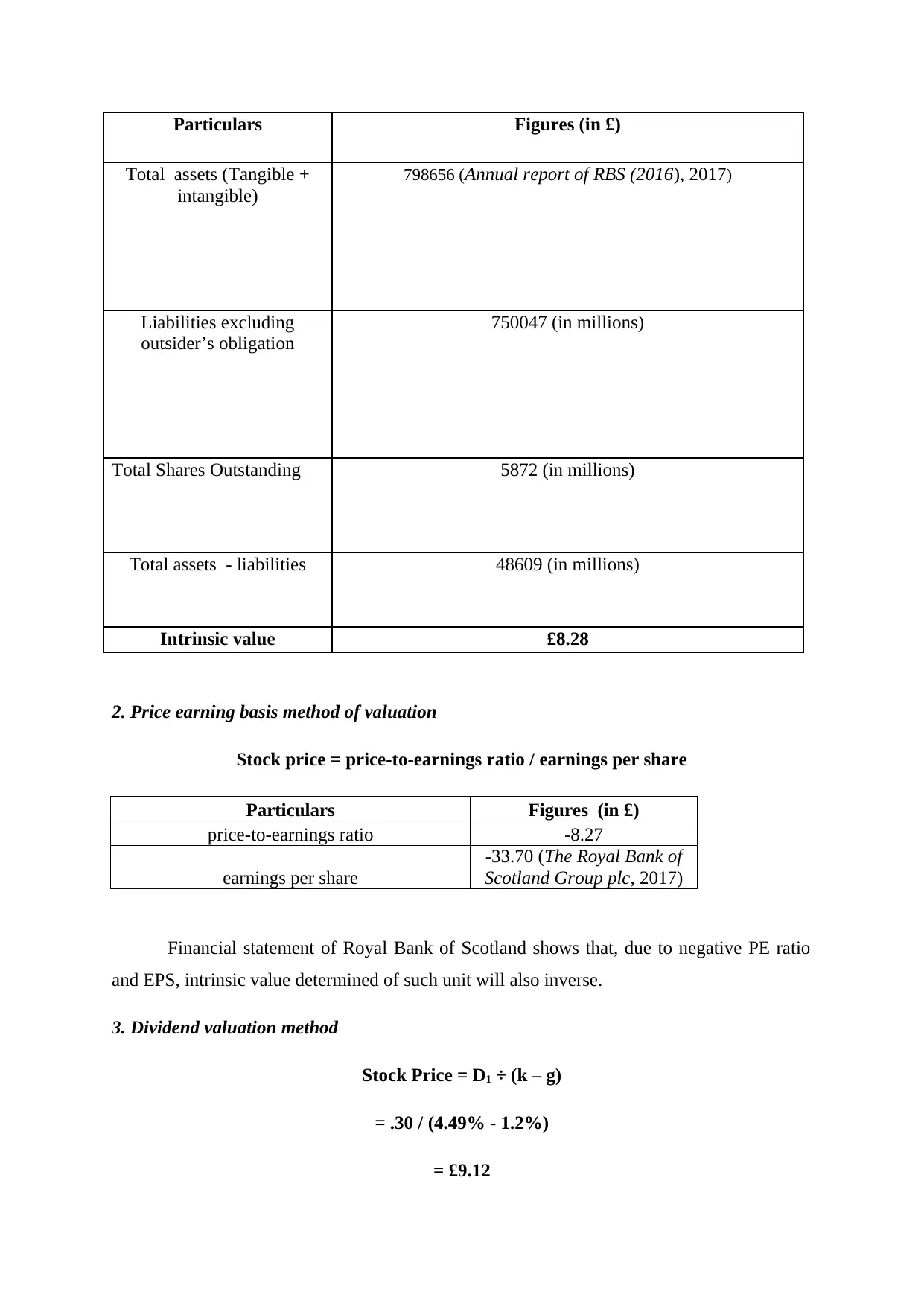
Particulars Figures (in £)
Total assets (Tangible +
intangible)
798656 (Annual report of RBS (2016), 2017)
Liabilities excluding
outsider’s obligation
750047 (in millions)
Total Shares Outstanding 5872 (in millions)
Total assets - liabilities 48609 (in millions)
Intrinsic value £8.28
2. Price earning basis method of valuation
Stock price = price-to-earnings ratio / earnings per share
Particulars Figures (in £)
price-to-earnings ratio -8.27
earnings per share
-33.70 (The Royal Bank of
Scotland Group plc, 2017)
Financial statement of Royal Bank of Scotland shows that, due to negative PE ratio
and EPS, intrinsic value determined of such unit will also inverse.
3. Dividend valuation method
Stock Price = D1 ÷ (k – g)
= .30 / (4.49% - 1.2%)
= £9.12
Total assets (Tangible +
intangible)
798656 (Annual report of RBS (2016), 2017)
Liabilities excluding
outsider’s obligation
750047 (in millions)
Total Shares Outstanding 5872 (in millions)
Total assets - liabilities 48609 (in millions)
Intrinsic value £8.28
2. Price earning basis method of valuation
Stock price = price-to-earnings ratio / earnings per share
Particulars Figures (in £)
price-to-earnings ratio -8.27
earnings per share
-33.70 (The Royal Bank of
Scotland Group plc, 2017)
Financial statement of Royal Bank of Scotland shows that, due to negative PE ratio
and EPS, intrinsic value determined of such unit will also inverse.
3. Dividend valuation method
Stock Price = D1 ÷ (k – g)
= .30 / (4.49% - 1.2%)
= £9.12
Paraphrase This Document
Need a fresh take? Get an instant paraphrase of this document with our AI Paraphraser
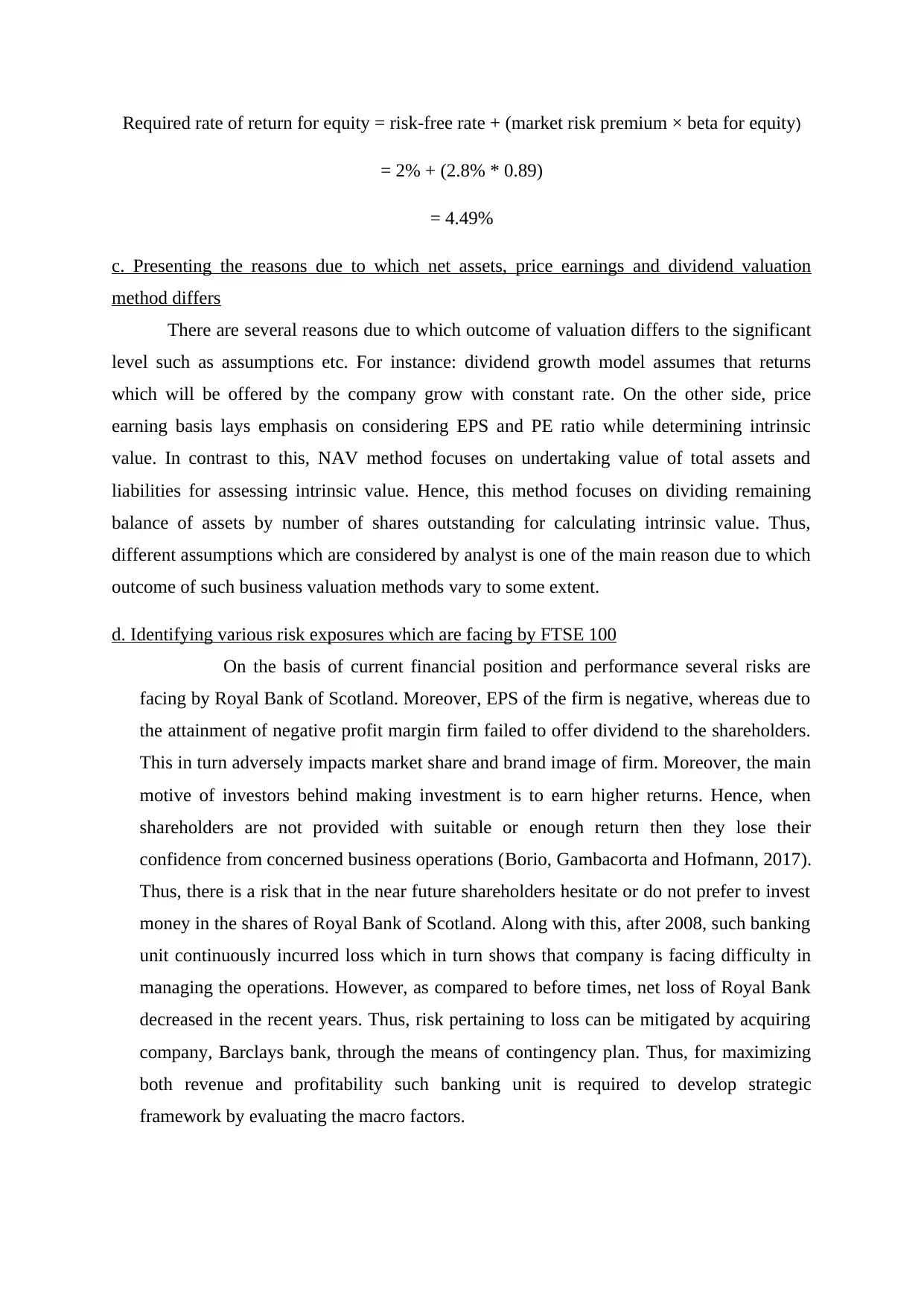
Required rate of return for equity = risk-free rate + (market risk premium × beta for equity)
= 2% + (2.8% * 0.89)
= 4.49%
c. Presenting the reasons due to which net assets, price earnings and dividend valuation
method differs
There are several reasons due to which outcome of valuation differs to the significant
level such as assumptions etc. For instance: dividend growth model assumes that returns
which will be offered by the company grow with constant rate. On the other side, price
earning basis lays emphasis on considering EPS and PE ratio while determining intrinsic
value. In contrast to this, NAV method focuses on undertaking value of total assets and
liabilities for assessing intrinsic value. Hence, this method focuses on dividing remaining
balance of assets by number of shares outstanding for calculating intrinsic value. Thus,
different assumptions which are considered by analyst is one of the main reason due to which
outcome of such business valuation methods vary to some extent.
d. Identifying various risk exposures which are facing by FTSE 100
On the basis of current financial position and performance several risks are
facing by Royal Bank of Scotland. Moreover, EPS of the firm is negative, whereas due to
the attainment of negative profit margin firm failed to offer dividend to the shareholders.
This in turn adversely impacts market share and brand image of firm. Moreover, the main
motive of investors behind making investment is to earn higher returns. Hence, when
shareholders are not provided with suitable or enough return then they lose their
confidence from concerned business operations (Borio, Gambacorta and Hofmann, 2017).
Thus, there is a risk that in the near future shareholders hesitate or do not prefer to invest
money in the shares of Royal Bank of Scotland. Along with this, after 2008, such banking
unit continuously incurred loss which in turn shows that company is facing difficulty in
managing the operations. However, as compared to before times, net loss of Royal Bank
decreased in the recent years. Thus, risk pertaining to loss can be mitigated by acquiring
company, Barclays bank, through the means of contingency plan. Thus, for maximizing
both revenue and profitability such banking unit is required to develop strategic
framework by evaluating the macro factors.
= 2% + (2.8% * 0.89)
= 4.49%
c. Presenting the reasons due to which net assets, price earnings and dividend valuation
method differs
There are several reasons due to which outcome of valuation differs to the significant
level such as assumptions etc. For instance: dividend growth model assumes that returns
which will be offered by the company grow with constant rate. On the other side, price
earning basis lays emphasis on considering EPS and PE ratio while determining intrinsic
value. In contrast to this, NAV method focuses on undertaking value of total assets and
liabilities for assessing intrinsic value. Hence, this method focuses on dividing remaining
balance of assets by number of shares outstanding for calculating intrinsic value. Thus,
different assumptions which are considered by analyst is one of the main reason due to which
outcome of such business valuation methods vary to some extent.
d. Identifying various risk exposures which are facing by FTSE 100
On the basis of current financial position and performance several risks are
facing by Royal Bank of Scotland. Moreover, EPS of the firm is negative, whereas due to
the attainment of negative profit margin firm failed to offer dividend to the shareholders.
This in turn adversely impacts market share and brand image of firm. Moreover, the main
motive of investors behind making investment is to earn higher returns. Hence, when
shareholders are not provided with suitable or enough return then they lose their
confidence from concerned business operations (Borio, Gambacorta and Hofmann, 2017).
Thus, there is a risk that in the near future shareholders hesitate or do not prefer to invest
money in the shares of Royal Bank of Scotland. Along with this, after 2008, such banking
unit continuously incurred loss which in turn shows that company is facing difficulty in
managing the operations. However, as compared to before times, net loss of Royal Bank
decreased in the recent years. Thus, risk pertaining to loss can be mitigated by acquiring
company, Barclays bank, through the means of contingency plan. Thus, for maximizing
both revenue and profitability such banking unit is required to develop strategic
framework by evaluating the macro factors.
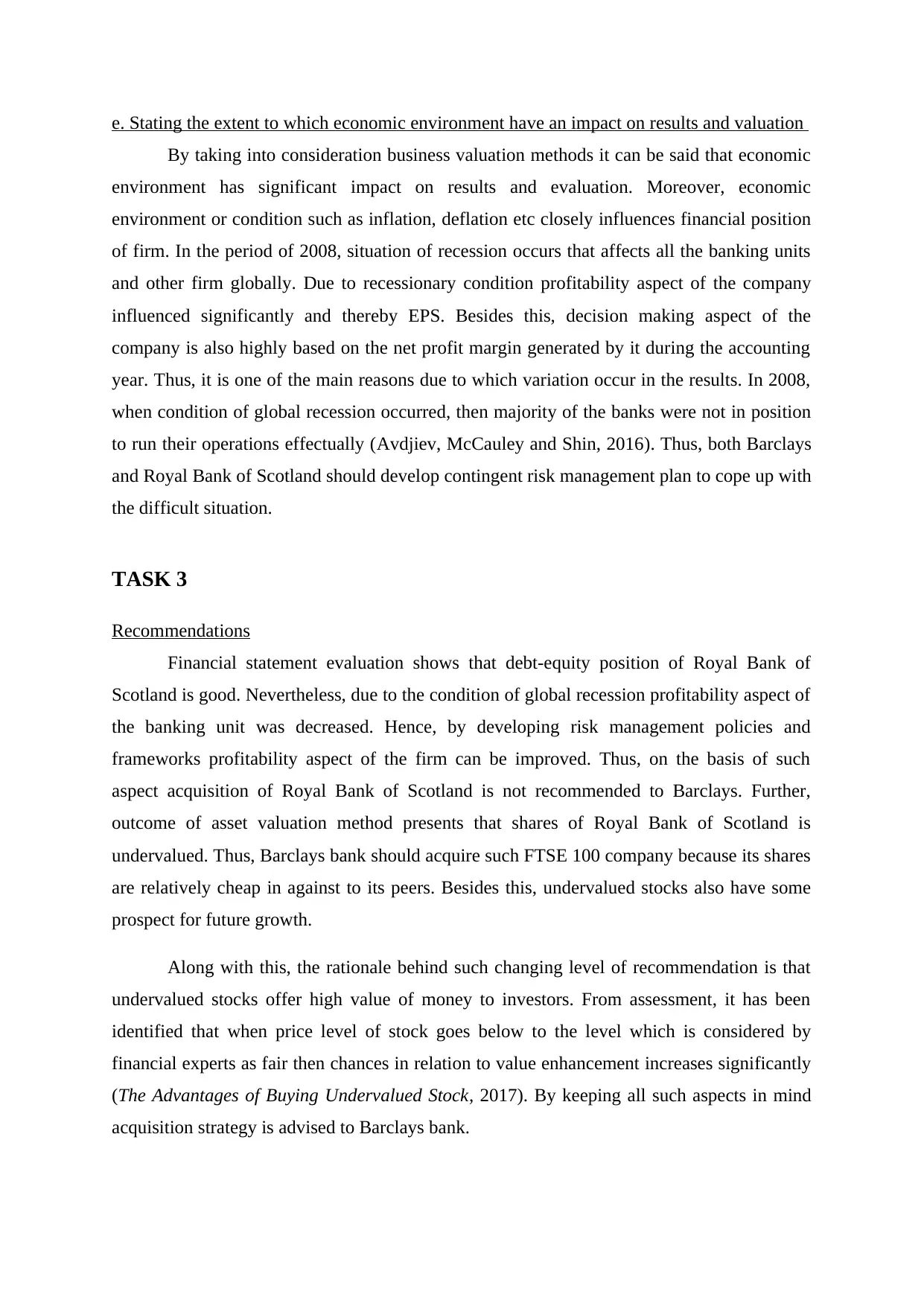
e. Stating the extent to which economic environment have an impact on results and valuation
By taking into consideration business valuation methods it can be said that economic
environment has significant impact on results and evaluation. Moreover, economic
environment or condition such as inflation, deflation etc closely influences financial position
of firm. In the period of 2008, situation of recession occurs that affects all the banking units
and other firm globally. Due to recessionary condition profitability aspect of the company
influenced significantly and thereby EPS. Besides this, decision making aspect of the
company is also highly based on the net profit margin generated by it during the accounting
year. Thus, it is one of the main reasons due to which variation occur in the results. In 2008,
when condition of global recession occurred, then majority of the banks were not in position
to run their operations effectually (Avdjiev, McCauley and Shin, 2016). Thus, both Barclays
and Royal Bank of Scotland should develop contingent risk management plan to cope up with
the difficult situation.
TASK 3
Recommendations
Financial statement evaluation shows that debt-equity position of Royal Bank of
Scotland is good. Nevertheless, due to the condition of global recession profitability aspect of
the banking unit was decreased. Hence, by developing risk management policies and
frameworks profitability aspect of the firm can be improved. Thus, on the basis of such
aspect acquisition of Royal Bank of Scotland is not recommended to Barclays. Further,
outcome of asset valuation method presents that shares of Royal Bank of Scotland is
undervalued. Thus, Barclays bank should acquire such FTSE 100 company because its shares
are relatively cheap in against to its peers. Besides this, undervalued stocks also have some
prospect for future growth.
Along with this, the rationale behind such changing level of recommendation is that
undervalued stocks offer high value of money to investors. From assessment, it has been
identified that when price level of stock goes below to the level which is considered by
financial experts as fair then chances in relation to value enhancement increases significantly
(The Advantages of Buying Undervalued Stock, 2017). By keeping all such aspects in mind
acquisition strategy is advised to Barclays bank.
By taking into consideration business valuation methods it can be said that economic
environment has significant impact on results and evaluation. Moreover, economic
environment or condition such as inflation, deflation etc closely influences financial position
of firm. In the period of 2008, situation of recession occurs that affects all the banking units
and other firm globally. Due to recessionary condition profitability aspect of the company
influenced significantly and thereby EPS. Besides this, decision making aspect of the
company is also highly based on the net profit margin generated by it during the accounting
year. Thus, it is one of the main reasons due to which variation occur in the results. In 2008,
when condition of global recession occurred, then majority of the banks were not in position
to run their operations effectually (Avdjiev, McCauley and Shin, 2016). Thus, both Barclays
and Royal Bank of Scotland should develop contingent risk management plan to cope up with
the difficult situation.
TASK 3
Recommendations
Financial statement evaluation shows that debt-equity position of Royal Bank of
Scotland is good. Nevertheless, due to the condition of global recession profitability aspect of
the banking unit was decreased. Hence, by developing risk management policies and
frameworks profitability aspect of the firm can be improved. Thus, on the basis of such
aspect acquisition of Royal Bank of Scotland is not recommended to Barclays. Further,
outcome of asset valuation method presents that shares of Royal Bank of Scotland is
undervalued. Thus, Barclays bank should acquire such FTSE 100 company because its shares
are relatively cheap in against to its peers. Besides this, undervalued stocks also have some
prospect for future growth.
Along with this, the rationale behind such changing level of recommendation is that
undervalued stocks offer high value of money to investors. From assessment, it has been
identified that when price level of stock goes below to the level which is considered by
financial experts as fair then chances in relation to value enhancement increases significantly
(The Advantages of Buying Undervalued Stock, 2017). By keeping all such aspects in mind
acquisition strategy is advised to Barclays bank.
⊘ This is a preview!⊘
Do you want full access?
Subscribe today to unlock all pages.

Trusted by 1+ million students worldwide
1 out of 15
Related Documents
Your All-in-One AI-Powered Toolkit for Academic Success.
+13062052269
info@desklib.com
Available 24*7 on WhatsApp / Email
![[object Object]](/_next/static/media/star-bottom.7253800d.svg)
Unlock your academic potential
Copyright © 2020–2025 A2Z Services. All Rights Reserved. Developed and managed by ZUCOL.





